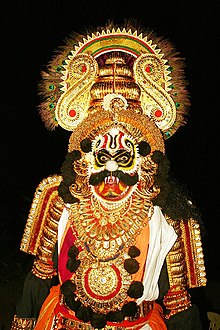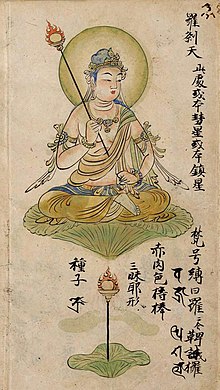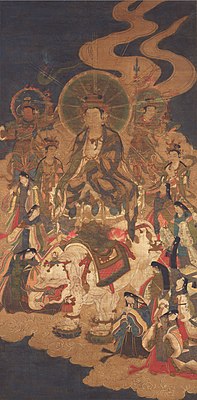Rakshasa
This articleneeds additional citations forverification.(June 2013) |
 Rakshasaas depicted inYakshagana,an art form ofUttara Kannada.Artist: Krishna Hasyagar, Karki | |
| Grouping | Demigod |
|---|---|
| Similar entities | Asura |
| Folklore | |
| Other name(s) |
|
| Country | India,Nepal,Sri Lanka,Myanmar,Thailand,Laos,Cambodia,Indonesia |
Rākshasa(Sanskrit:राक्षस,IAST:rākṣasa,pronounced[raːkʂɐsɐ];Pali:rakkhasa;lit."preservers" )[1]are a race of usually malevolent beings prominently featured inHinduism,Buddhism,JainismandFolk Islam.They reside on Earth but possess supernatural powers, which they usually use for evil acts such as disruptingVedic sacrificesor eating humans.[2][3]
They are offered a distinction fromyakshas,their cousins who are depicted to be forces of destruction. The term is also used to describeasuras,a class of power-seeking beings that oppose the benevolentdevas.They are often depicted as antagonists inHinduscriptures, as well as inBuddhismandJainism.The female form of rakshasa israkshasi.[4]
Hinduism
[edit]This section has multiple issues.Please helpimprove itor discuss these issues on thetalk page.(Learn how and when to remove these messages)
|
In Puranas
[edit]Brahmā, in a form composed of the quality of foulness, produced hunger, of whom anger was born: and the god put forth in darkness beings emaciate with hunger, of hideous aspects, and with long beards. Those beings hastened to the deity. Such of them as exclaimed, “Oh preserve us!” were thence called Rākṣasas.[5]Those created beings, overwhelmed by hunger, attempted to seize the waters. Those among them who said— “we shall protect these waters”, are remembered as Rākṣasas.[6]
Description
[edit]Rakshasas were most often depicted as shape-shifting, fierce-looking, enormous monstrous-looking creatures, with twofangsprotruding from the top of the mouth and having sharp, claw-like fingernails. They were shown as being mean, growling beasts, and as insatiableman-eatersthat could smell the scent of human flesh. Some of the more ferocious ones were shown with flaming red eyes and hair, drinkingbloodwith their cupped hands or from human skulls (similar to representations ofvampiresin later Western mythology). Generally they could fly, vanish, and hadmaya(magical powers of illusion), which enabled them to change size at will and assume the form of any creature. The female equivalent of rakshasa is rakshasi.[7]
In Hindu epics
[edit]In the world of theRamayanaandMahabharata,Rakshasas were a populous race. There were both good and evil rakshasas, and as warriors they fought alongside the armies of both good and evil. They were powerful warriors, expert magicians and illusionists. As shape-changers, they could assume different physical forms. As illusionists, they were capable of creating appearances which were real to those who believed in them or who failed to dispel them. Some of the rakshasas were said to be man-eaters, and made their gleeful appearance when the slaughter on a battlefield was at its worst. Occasionally they served as rank-and-file soldiers in the service of one or another warlord.
Aside from their treatment of unnamed rank-and-file Rakshasas, the epics tell the stories of certain members of these beings who rose to prominence, sometimes as heroes but more often as villains.
Thaparsuggests that the Rakshasas could represent exaggerated, supernatural depictions of demonized forest-dwellers who were outside the caste society.[8]
In theRāmāyaṇa
[edit]In books 3-6 of theRāmāyaṇa,the rākṣasas are the main antagonists of the narrative. The protagonist Rāma slays many rākṣasas throughout the epic, includingTāṭakā,Mārīca,andRāvaṇa.[3]In the epic, the rākṣasas are portrayed as mainly demonic beings who are aggressive and sexual. They can assume any form they wish, which Rāvaṇa uses to good effect to trick and kidnap Sītā, Rāma's wife, which drives the rest of the narrative. The rākṣasas reside in the forests south of the Gangetic plain and in the island fortress ofLaṅkā,both far away from the lands ofKosalaand the home of Rāma. In Laṅkā, the capital of Rāvaṇa, the rākṣasas live in a complex society comparable to the humans ofAyodhyā,where some rākṣasas such asVibhīṣaṇaare moral beings.[9]

In the Mahabharata
[edit]ThePandavaheroBhimawas the nemesis of forest-dwelling Rakshasas who dined on human travellers and terrorized human settlements.
- Bhima killedHidimba,a cannibal Rakshasa. TheMahabharatadescribes him as a cruel cannibal with sharp, long teeth and prodigious strength.[10]When Hidimba saw the Pandavas sleeping in his forest, he decided to eat them. He sent his sisterHidimbito reconnoiter the situation, and the young woman fell in love with the handsome Bhima, whom she warned of danger. Infuriated, Hidimba declared he was ready to kill not only the Pandavas but also his sister, but he was thwarted by the heroism of Bhima, who defeated and killed him in a duel.
- Ghatotkacha,a Rakshasa who fought on the side of the Pandavas, was the son of Bhima and the Rakshasi Hidimbi, who had fallen in love with the hero and warned him of danger from her brother. Bhima killed the evil Rakshasa Hidimba. Their son's name refers to his round bald head;ghatameans 'pot' andutkachameans 'head' inSanskrit.Ghatotkacha is considered a loyal and humble figure. He and his followers were available to his father Bhima at any time; all Bhima had to do was to think of him and he would appear. Like his father, Ghatotkacha primarily fought with themace.His wife wasAhilawatiand his sons wereAnjanaparvana,Barbarika,and Meghavarna.
In theMahabharata,Ghatotkacha was summoned by Bhima to fight on the Pandava side in theKurukshetra War.Invoking his magical powers, he wrought great havoc in the Kaurava army. In particular, after the death ofJayadratha,when the battle continued on past sunset, his powers were at their most effective (at night). After performing many heroic deeds on the battlefield and fighting numerous duels with other great warriors (including the Rakshasa Alamvusha, the elephant-riding KingBhagadatta,andAswatthaman,the son ofDrona), Ghatotkacha encountered the human heroKarna.At this point in the battle, the Kaurava leaderDuryodhanahad appealed to his best fighter,Karna,to kill Ghatotkacha, as the entire Kaurava army was near annihilation due to his ceaseless strikes from the air. Karna possessed a divine weapon,Shakti,granted by the god Indra. It could be used only once and Karna had been saving it to use on his arch-enemyArjuna,the best Pandava fighter. Unable to refuse Duryodhana, Karna used the Shakti against Ghatotkacha, killing him. This is considered to be the turning point of the war. After his death, the Pandava counselorKrishnasmiled, as he considered the Pandava prince Arjuna to be saved from certain death, as Karna had used theShaktadivine weapon. A temple inManali,Himachal Pradesh,honors Ghatotkacha; it is located near theHidimba Devi Temple.
- Bakasurawas a cannibalistic forest-dwelling Rakshasa who terrorized the nearby human population by forcing them to take turns making him regular deliveries of food, including human victims. The Pandavas travelled into the area and took up residence with a localBrahminfamily. Their turn came when they had to make a delivery to Bakasura, and they debated who among them should be sacrificed. The rugged Bhima volunteered to take care of the matter. Bhima went into the forest with the food delivery (consuming it on the way to annoy Bakasura). He engaged Bakasura in a ferocious wrestling match, and broke his back. The human townspeople were amazed and grateful. The local Rakshasas begged for mercy, which Bhima granted them on the condition that they give up cannibalism. The Rakshasas agreed and soon acquired a reputation for being peaceful towards humans.[11]
- Kirmira,the brother of Bakasura, was a cannibal and master illusionist. He haunted the wood of Kamyaka, dining on human travellers. Like his brother before him, Kirmira also made the mistake of fighting the Pandav hero Bhima, who killed him with his bare hands.[12]
- Jatasurawas a cunning Rakshasa who, disguised as aBrahmin,attempted to steal the Pandavas' weapons and to ravishDraupadi,wife of the five Pandavas. Bhima arrived in time to intervene, and killed Jatasur in a duel.[13]Jatasur's son was Alamvush, who fought on the side of theKauravasatKurukshetra.
Rakshasa heroes fought on both sides in the Kurukshetra war.
- Alamvusha was a Rakshasa skilled at fighting with both conventional weapons and the powers of illusion. According to theMahabharata,he fought on the side of the Kauravas.Arjunadefeated him in a duel,[14]as did Arjuna's sonAbhimanyu.[15]But Alamvusha in turn killedIravan,Arjuna's son by aNāgaprincessUlupi,when the Rakshasa used his powers of illusion to take on the form ofGaruda.[16]Alamvusha was also defeated by Bhima.[17]He was slain by Bhima's son, the Rakshasa Ghatotkacha.[18]
Buddhism
[edit]Many Rakshasas appear in various Buddhist Scriptures. In Chinese tradition rakshasa are known asluosha(La sát/La sát).[19]In Japan, they are known asrasetsu(La sát).
Chapter 26 of theLotus Sutraincludes a dialogue between the Buddha and a group of rakshasa daughters, who swear to uphold and protect theLotus Sutra.They also teach magicaldhāraṇīsto protect followers who also uphold the sutra.[20]
Five rakshasha are part ofMahakala's retinue. They are Kala and Kali, husband and wife, and their offspring Putra, Bhatri and Bharya.[21]
The Lankavatara Sutramentions the island ofSri Lankaas land of Rakshasas. Their king is the Rakshasa called Ravana, who invitesBuddhato Sri Lanka for delivering the sermon in the land. There are other Rakhasas from the land, such as Wibisana, who is believed to be the brother of Ravana inSri Lankan Buddhist mythology.[22]
InThe Lotus-Born: The Life Story of Padmasambhava, recorded byYeshe Tsogyal,Padmasambhavareceives thenicknameof "Rakshasa" during one of his wrathful conquests to subdue Buddhistheretics.
-
Painting of Rakshasa as one of the Twelve Devas of theVajrayanatradition.
Japan,Heian period,1127 CE. -
Rakshasa as a single deity, depicted on a page from a folio describing deities from theDiamond RealmandWomb Realm.
Japan, Heian period, 12th century.
Jainism
[edit]Jainaccounts vary from theHinduaccounts of Rakshasa. According toJain literature,Rakshasa was a kingdom of civilized and vegetarian people belonging to the race ofVidyadhara,who were devotees ofTirthankara.[23]
Islam
[edit]Kejawèn-influencedIndonesianMuslimsview the Rakshasas as the result of people whose soul is replaced by the spirit of a devil (shayāṭīn). The devils are envious of humans and thus attempt to possess their body and minds. If they succeed, the human adapts to the new soul and gains their qualities, turning the person into a Rakshasa.[24]
Artistic and folkloric depictions
[edit]
The artists ofAngkorinCambodiafrequently depictedRavanain stone sculpture andbas-relief.The "Nāgabridge "at the entrance to the 12th-century city ofAngkor Thomis lined with large stone statues ofDevasand Asuras engaged in churning theOcean of Milk.The ten-headedRavanais shown anchoring the line of Asuras.[25]
A bas-relief at the 12th-century temple ofAngkor Watdepicts the figures churning the ocean. It includesRavanaanchoring the line of Asuras that are pulling on the serpent's head. Scholars have speculated that one of the figures in the line ofDevasis Ravana's brotherVibhishana.They pull on a serpent's tail to churn the Ocean of Milk.[26]Another bas-relief at Angkor Wat shows a 20-armed Ravana shakingMount Kailasa.[27]
The artists of Angkor also depicted the Battle of Lanka between the Rakshasas under the command ofRavanaand the Vanaras or monkeys under the command ofRamaandSugriva.The 12th-century Angkor Wat contains a dramatic bas-relief of the Battle of Lanka between Ravana's Rakshasas andRama's monkeys. Ravana is depicted with ten heads and twenty arms, mounted on a chariot drawn by creatures that appear to be a mixture of horse, lion, and bird. Vibhishana is shown standing behind and aligned with Rama and his brotherLakshmana.Kumbhakarna,mounted on a similar chariot, is shown fightingSugriva.[28]
This battle is also depicted in a less refined bas-relief at the 12th-century temple ofPreah Khan.
In fiction
[edit]Rakshasahave long been a race of villains in theDungeons & Dragonsrole-playing game. They appear as animal-headed humanoids (generally with tiger or monkey heads) with their hands inverted (palms of its hands are where the backs of the hands would be on a human). They are masters of necromancy, enchantment and illusion (which they mostly use to disguise themselves) and are very hard to kill, especially due to their partial immunity to magical effects. They ravenously prey upon humans as food and dress themselves in fine clothing.[29]This version of the rakshasa was heavily inspired by an episode ofKolchak: The Night Stalker[30]entitled "Horror in the Heights," which aired on December 20, 1974.[citation needed]
Rakshasa appears in theUnicorn: Warriors Eternalepisode "Darkness Before Dawn". He is a humanoid tiger similar to theD&Ddepiction. This version is a fierce but benevolent guardian of the jungle who allies withMerlinagainst the Evil.[31]
In the filmWorld War Z,Rakshasa were mentioned in reference to the zombies in India.[32]
In languages
[edit]InIndonesianandMalaysianvariants ofMalaywhich have significantSanskritinfluence,raksasanow means "giant", "gigantic", "huge and strong";[33]the Malaysian variant recognises the word as an outright official equivalent to "monster"[34]whereas the Indonesian variant uses it more in colloquial usage.[33]
See also
[edit]- Asura
- Brahmarakshasa
- Daitya
- Danava
- List of Rakshasas
- Ogre
- Oni
- Troll
- Wrath of Rakshasa(Six Flags Great AmericaDive Coaster)
Citations
[edit]- ^www.wisdomlib.org (18 April 2019)."God Brahmā's mental creation [Chapter 8]".www.wisdomlib.org.Retrieved16 June2022.
- ^Skyes, Edgerton; Kendall, Alan; Sykes, Egerton (4 February 2014).Who's Who in Non-Classical Mythology.Routledge. p. 163.ISBN978-1-136-41437-4.
- ^abRodrigues, Hillary (2018). "Asuras, Daityas, Dānavas, Rākṣasas, Piśācas, Bhūtas, Pretas, and so forth". In Knut, A. Jacobsen; Basu, Helene; Malinar, Angelika; Narayanan, Vasudha (eds.).Brill's Encyclopedia of Hinduism Online.Brill.
- ^Knappert, Jan (1991).Indian Mythology: An Encyclopedia of Myth and Legend.Aquarian Press. p. 148.ISBN978-1-85538-040-0.
- ^"The Vishnu Purana, Book 1:Chapter 8".Wisdom Library. 30 August 2014.
- ^"The Brahmanda Purana, Section 2: Chapter 8".Wisdom Library. 18 April 2019.
- ^Gopal, Madan (1990). K.S. Gautam (ed.).India through the Ages.Publication Division, Ministry of Information and Broadcasting, Government of India. p.72.
- ^Thapar, Romila (2002).Early India: From the Origins to AD 1300.Berkeley, Los Angeles: University of California Press. pp. 55–56.ISBN0-520-23899-0.
- ^Pollock, Sheldon I. (1991). "Rākṣasas and Others". In Goldman, Robert P. (ed.).The Rāmāyaṇa of Vālmīki: An Epic of Ancient India, Volume III: Araṇyakāṇda.Princeton University Press. pp. 68–84.
- ^Mahabharata, Book I: Adi Parva, Section 154
- ^Mahabharata, Book I: Adi Parva, Sections 159-166.)
- ^Mahabharata, Book III: Varna Parva, Section 11
- ^Mahabharata, Book III: Varna Parva, Section 156
- ^Mahabharata, Book VII: Drona Parva, Section 167
- ^Mahabharata, Book VI: Bhishma Parva, Section 101–102
- ^Ganguli (1883–1896). "Section XCI".The Mahabharata Book 6: Bhishma Parva.Retrieved7 May2010.
- ^Mahabharata, Book VII: Drona Parva, Section 107
- ^Mahabharata, Book VII: Drona Parva, Section 108
- ^The Contemporary Chinese Dictionary.2002.ISBN7-5600-3195-1.
- ^Lotus Sutra, chapter 26, Burton Watson translationArchived25 March 2003 atarchive.today
- ^John C. Huntington, Dina Bangdel (2003).The Circle of Bliss: Buddhist Meditational Art.Serindia Publications. p. 335.ISBN9781932476019.
- ^"The Lankavatara Sutra. A Mahayana Text".lirs.ru.Retrieved16 April2021.
- ^"Jainism Resource Center - Articles".sites.fas.harvard.edu.Retrieved7 January2020.
- ^Woodward, Mark (2010).Java, Indonesia and Islam.Springer Netherlands. p. 88.
- ^Rovedo 1997,p. 108
- ^Rovedo 1997,pp. 108–110;Freeman & Jacques 2003,p. 62
- ^Freeman & Jacques 2003,p. 57
- ^Rovedo 1997,pp. 116–117
- ^Monster Manuel Core Rulebook III V3.5 Cook, Tweet, Williams
- ^"TSR - Q&A with Gary Gygax".29 August 2002.
- ^Kaldor, David (17 June 2023)."Review: Unicorn: Warriors Eternal" Darkness Before the Dawn "".Bubbleblabber.Retrieved22 June2023.
- ^Agrawal, Sahil (4 July 2013).""World War Z" As Mindless As Its Undead ".The Harvard Crimson.Retrieved16 July2023.
- ^abAtmosumarto, Sutanto (2004).A learner's comprehensive dictionary of Indonesian.Atma Stanton. p. 445.ISBN9780954682804.
- ^"'monster' - Kamus Bahasa Inggeris [English Dictionary] ".Pusat Rujukan Persuratan Melayu.Retrieved20 June2020.
General references
[edit]- Freeman, Michael; Jacques, Claude (2003).Ancient Angkor.Bangkok: River Books.
- Rovedo, Vittorio (1997).Khmer Mythology: Secrets of Angkor.New York: Weatherhill.
Further reading
[edit]- Pollock, Sheldon (1985/1986)."Rakshasas and others"Archived24 September 2015 at theWayback Machine(PDF),Indologica Taurinensiavol. 13, pp. 263–281.
External links
[edit]- The Mahabharataof Vyasa translated from Sanskrit into English by Kisari Mohan Ganguli, online version




